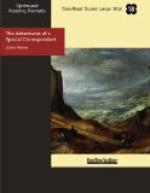The two principal stations have been Yanghi-Hissar, where the train stops ten minutes, and Kizil, where it stops a quarter of an hour. Several blast furnaces are at work here, the soil being ferruginous, as is shown by the word “Kizil,” which means red.
The country is fertile and well cultivated, growing wheat, maize, rice, barley and flax, in its eastern districts. Everywhere are great masses of trees, willows, mulberries, poplars. As far as the eye can reach are fields under culture, irrigated by numerous canals, also green fields in which are flocks of sheep; a country half Normandy, half Provence, were it not for the mountains of the Pamir on the horizon. But this portion of Kachgaria was terribly ravaged by war when its people were struggling for independence. The land flowed with blood, and along by the railway the ground is dotted with tumuli beneath which are buried the victims of their patriotism. But I did not come to Central Asia to travel as if I were in France! Novelty! Novelty! The unforeseen! The appalling!
It was without the shadow of an accident, and after a particularly fine run, that we entered Yarkand station at four o’clock in the afternoon.
If Yarkand is not the administrative capital of eastern Turkestan, it is certainly the most important commercial city of the province.
“Again two towns together,” said I to Major Noltitz. “That I have from Popof.”
“But this time,” said the major, “it was not the Russians who built the new one.”
“New or old,” I added, “I am afraid is like the others we have seen, a wall of earth, a few dozen gateways cut in the wall, no monuments or buildings of note, and the eternal bazaars of the East.”
I was not mistaken, and it did not take four hours to visit both Yarkands, the newer of which is called Yanji-Shahr.
Fortunately, the Yarkand women are not forbidden to appear in the streets, which are bordered by simple mud huts, as they were at the time of the “dadkwahs,” or governors of the province. They can give themselves the pleasure of seeing and being seen, and this pleasure is shared in by the farangis—as they call foreigners, no matter to what nation they may belong. They are very pretty, these Asiatics, with their long tresses, their transversely striped bodices, their skirts of bright colors, relieved by Chinese designs in Kothan silk, their high-heeled embroidered boots, their turbans of coquettish pattern, beneath which appear their black hair and their eyebrows united by a bar.
A few Chinese passengers alighted at Yarkand, and gave place to others exactly like them—among others a score of coolies—and we started again at eight o’clock in the evening.
During the night we ran the three hundred and fifty kilometres which separate Yarkand from Kothan.
A visit I paid to the front van showed me that the box was still in the same place. A certain snoring proved that Kinko was inside as usual, and sleeping peacefully. I did not care to wake him, and I left him to dream of his adorable Roumanian.




